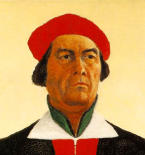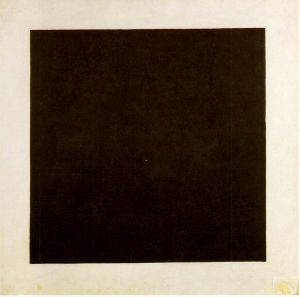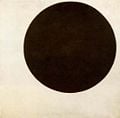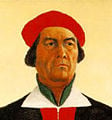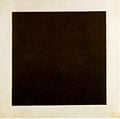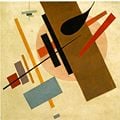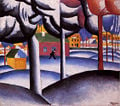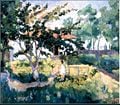Kazimir Malevich
Kazimir Severinovich Malevich (Russian: Казимир Северинович Малевич, Polish: Malewicz, Ukrainian transliteration Malevych, German: Kasimir Malewitsch), (February 23, 1878 – May 15, 1935) was a painter and art theoretician, pioneer of geometric abstract art and one of the most important members of the Russian avant-garde.
Life and work
Kasimir Malevich was born near Kiev, Ukraine. His parents, Seweryn and Ludwika Malewicz, were Polish Catholics, and he was baptized in the Roman Catholic Church. His father was the manager of a sugar factory. Kazimir was the first of fourteen children, although only nine of the children survived into adulthood. His family moved often and he spent most of his childhood in the villages of Ukraine. He studied drawing in Kiev from 1895 to 1896.
In 1904 he moved to Moscow. He studied at the Moscow School of Painting, Sculpture and Architecture from 1904 to 1910. and in the studio of Fedor Rerberg in Moscow (1904–1910). In 1911 he participated in the second exhibition of the group Soyus Molod'ozhi (Union of Youth) in St. Petersburg, together with Vladimir Tatlin and, in 1912, the group held its third exhibition, including works by Aleksandra Ekster, Tatlin and others. In the same year he participated in exhibition of the collective Donkey's Tail in Moscow. In 1914 Malevich exhibited works in the Salon des Independants in Paris together with Alexander Archipenko, Sonia Delaunay, Aleksandra Ekster and Vadim Meller, among others. In 1915 he published his manifesto From Cubism to Suprematism. In 1915–1916 he worked with other Suprematist artists in a peasant/artisan co-operative in Skoptsi and Verbovka village. In 1916–1917 he participated in exhibitions of the Jack of Diamonds group in Moscow together with Nathan Altman, David Burliuk and A. Ekster, among others.
After early experiments with various modernist styles including Cubism and Futurism — as exemplified by his costume and set work on the Cubo-Futurist opera Victory Over the Sun — Malevich began working with abstract, non-objective geometric patterns, founding a movement he called Suprematism. Famous examples of his Suprematist works include Black Square (1915) and White on White (1918).
Malevich also acknowledged that his fascination with aerial photography and aviation led him to abstractions inspired by or derived from aerial landscapes. Harvard doctoral candidate Julia Bekman Chadaga writes: “In his later writings, Malevich defined the 'additional element' as the quality of any new visual environment bringing about a change in perception .... In a series of diagrams illustrating the ‘environments' that influence various painterly styles, the Suprematist is associated with a series of aerial views rendering the familiar landscape into an abstraction..." (Excerpted from Ms. Bekman Chadaga's paper delivered at Columbia University's 2000 symposium, Technology, and Modernity in Russia and Eastern Europe')
Malevich was a member of the Collegium on the Arts of Narkompros, the commission for the protection of monuments and the museums commission (all from 1918–1919). He taught at the Vitebsk Practical Art School in Russia (now part of Belarus) (1919–1922), the Leningrad Academy of Arts (1922–1927), the Kiev State Art Institute (1927–1929), and the House of the Arts in Leningrad (1930). He wrote the book '’'The World as Non-Objectivity’ (Munich 1926; English trans. 1976) which outlines his Suprematist theories.
In 1927, he traveled to Warsaw and then to Germany for a retrospective that brought him international fame, and arranged to leave most of the paintings behind when he returned to the Soviet Union. When the Stalinist regime turned against modernist "bourgeois" art, Malevich was persecuted. Many of his works were confiscated or destroyed, and he died in poverty and obscurity in Leningrad, Soviet Union (today Saint Petersburg, Russia).
Trivia
The possible smuggling of surviving Malevich paintings out of Russia is a key to the plot line of Martin Cruz Smith's thriller "Red Square".
Selected works
- 1912 Morning in the Country after Snowstorm
- 1912 The Woodcutter
- 1912-13 Reaper on Red Background
- 1914 The Aviator
- 1914 An Englishman in Moscow
- 1914 Soldier of the First Division
- 1915 Black Square and Red Square
- 1915 Red Square: Painterly Realism of a Peasant Woman in Two Dimensions
- 1915 Suprematist Composition
- 1915 Suprematism (1915)
- 1915 Suprematist Painting: Aeroplane Flying
- 1915 Suprematism: Self-Portrait in Two Dimensions
- 1915-16 Suprematist Painting (Ludwigshafen)
- 1916 Suprematist Painting (1916)
- 1916 Supremus No. 56
- 1916-17 Suprematism (1916-17)
- 1917 Suprematist Painting (1917)
- 1928-32 Complex Presentiment: Half-Figure in a Yellow Shirt
- 1932-34 Running Man
See also
- Lyubov Popova
- Aleksandra Ekster
- El Lissitzky
- UNOVIS
- Suprematism
- Supremus
- IRWIN
- Aerial landscape art
External links and references
- Guggenheim: Kazimir Malevich
- "Black Square"
- "White on White"
- "Malevich on Film"
- DA Collection
- "Victory Over the Sun" discussed
- The Non-objective World, Kasimir Malevich, trans. Howard Dearstyne, Paul Theobald, 1959
- Kazimir Malevich and Suprematism 1878-1935, Gilles Néret, Taschen, 2003
- Dreikausen, Margret, "Aerial Perception: The Earth as Seen from Aircraft and Spacecraft and Its Influence on Contemporary Art" (Associated University Presses: Cranbury, NJ; London, England; Mississauga, Ontario: 1985) ISBN 0-87982-040-3
Credits
New World Encyclopedia writers and editors rewrote and completed the Wikipedia article in accordance with New World Encyclopedia standards. This article abides by terms of the Creative Commons CC-by-sa 3.0 License (CC-by-sa), which may be used and disseminated with proper attribution. Credit is due under the terms of this license that can reference both the New World Encyclopedia contributors and the selfless volunteer contributors of the Wikimedia Foundation. To cite this article click here for a list of acceptable citing formats.The history of earlier contributions by wikipedians is accessible to researchers here:
The history of this article since it was imported to New World Encyclopedia:
Note: Some restrictions may apply to use of individual images which are separately licensed.
